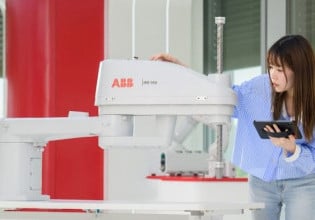A Hands-On Solution: Humanoid Robots in Automotive Manufacturing and Beyond
Two companies, Figure AI Inc. and Ubtech Robotics, are working to make humanoid robots viable for use in tasks traditionally developed for human hands.
In an era where automation continues to reshape industries, humanoid robots might offer benefits beyond what robots designed for single tasks can provide. Shenzhen-based Ubtech Robotics and California-born Figure AI Inc. are designing robots that can integrate into our existing world, rather than the other way around.

Figure and Ubtech Robotics are developing general-purpose, humanoid robots for industrial and commercial use. Image used courtesy of Figure
Robots Designed To Fit Our World
Unlike their single-task counterparts, humanoid robots theoretically possess the ability to use many different types of machinery, equipment, and tools originally tailored for human labor. This adaptability can help streamline processes across many industries and might also improve efficiency within industrial settings.
As single-task robots approach their limitations, humanoid robots' diverse capabilities look to be the next step in revolutionizing automation. The Walker S from Ubtech and Figure 01 from Figure are looking to change how robotics and automation are approached, starting in the automotive manufacturing industry.
Figure has received over $675 million in investments to develop humanoid robots for use across industries. Video used courtesy of Figure
Figure’s Figure 01
Figure is an AI robotics startup company looking to bring the first effective humanoid robot to industrial and commercial applications. The company has received $675 million in investment funding from several sources, including:
-
Jeff Bezos' Explore Investments LLC fund, $100 million
-
Microsoft, $95 million
-
Nvidia, $50 million
-
Amazon-affiliated fund, $50 million
-
OpenAI, $5 million
Other investors include Intel's venture capital arm, Samsung Ventures, and LG Innotek.
Figure believes it will be easier to design a robot based on the human form and function than to change the work environment to fit the robot, which has been the traditional approach. Figure is looking to meld AI technology with robotics technology to create an intelligent humanoid design that easily integrates into the world of humans, starting at the factory floor and eventually moving into other areas of life. The company has formed an agreement with BMW Manufacturing to pilot its robots in automotive manufacturing.
Ubtech’s humanoid robot working on NIO’s EV assembly line. Video used courtesy of Ubtech Robotics
Ubtech Robotics’ Walker S
The Walker S, a humanoid robot designed by Ubtech Robotics, has recently been tested on an EV assembly line at the Chinese EV company NIO. The Walker S features lithium iron phosphate batteries with a run time of two hours from a charge of two hours. While information on the Walker S is limited, Ubtech’s similar model designed for home and office, the Walker, has 36 degrees of freedom and an arm reach of 540 mm. Currently, the Walker S is being used for quality inspections of headlight covers, door locks, and seat belts.
Humanoid Robots in Industrial Automation
So, what does a fully functional humanoid mean for the future of automation and robotics? It is tough to predict the effects of this new approach to robotics, but it is possible that it will change the manufacturing sector and other industries. One thing is clear: this change of thinking in automation has a lot of potential, especially with the new tools available to help usher in its success.
The combination of advanced robotics and AI technology has the ability to open up new avenues for future expansion and prosperity. Robots directly replacing human labor create numerous applications and growth potential while liberating humans from physical tasks to pursue more meaningful endeavors.





